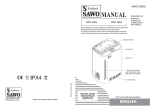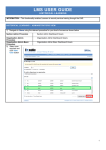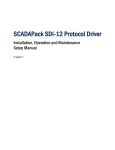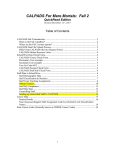Download ELECTRICAL TECHNOLOGY 2008 - Department of Basic Education
Transcript
ELECTRICAL TECHNOLOGY GUIDELINES FOR PRACTICAL ASSESSMENT TASKS 2008 This guideline consists of 23 pages. Copyright reserved Please turn over Electrical Technology 2 NSC DoE/PAT 2008 TABLE OF CONTENTS INTRODUCTION SECTION A (Educator Guide) The structure of the PAT 1.1 The Design Portfolio 1.1.1 Structure of the Design Portfolio A Stage 1 – The Problem Statement B Stage 2 – The Design C Stage 3 – The Make D Stage 4 – the Formal Evaluation Process 1. 2. Administration of the PAT 3. Assessment and moderation of the PAT 3.1 Assessment 3.2 Moderation 3.3 Declaration of Authenticity SECTION B (The Learner Task) 1. Scenario 1.1 Design Brief 1.2 Design Criteria 1.3 The Artefact 2 The Design Portfolio 3 Completing the PAT 3.1 Stage 1 - Problem Statement 3.2 Stage 2 - The Design 3.2.1 Research Task 1 3.2.2 Capability Task 1 3.3 Stage 3 - The Make 3.3.1 Capability Task 2 3.3.2 Capability Task 3 3.4 Stage 4 – Formal Evaluation 3.4.1 Capability Task 4 4 Assessment of the PAT 4.1 Problem Statement - Rubric 4.2 Research Task 1 - Rubric 4.3 Capability Task 1 - Rubric 4.4 Capability Task 2 - Rubric 4.5 Capability Task 3 - Rubric 4.6 Capability Task 4 - Checklist 4.7 Artefact Criterion Reference Checklist 4.8 Learner Summary Record Sheet 4.9 Holistic Rubric for assessment of the Artefact 4.10 Holistic Rubric for the assessment of the Design Portfolio Copyright reserved Please turn over Electrical Technology 3 NSC DoE/PAT 2008 INTRODUCTION The seventeen National Curriculum Statement subjects which contain a practical component all include a Practical Assessment Task (PAT), i.e. a Practical or Performance Assessment Task. These subjects are: AGRICULTURE: Agricultural Management Sciences, Agricultural Technology ARTS: Dance Studies, Design, Dramatic Arts, Music, Visual Arts HSS: Life Orientation SCIENCES: Computer Applications Technology, Information Technology SERVICES: Consumer Studies, Hospitality Studies, Tourism TECHNOLOGY: Civil Technology, Electrical Technology, Engineering Graphics and Design, Mechanical Technology A PAT allows the teacher to directly and systematically observe applied competence. The PAT comprises the application/performance of the knowledge, skills and values particular to that subject and counts 25% (i.e. 100 marks) of the total promotion/ certification mark out of 400 for the subject. In the two Art subjects, Design and Visual Arts, the PAT counts 37,5% (i.e. 150 marks) of the total promotion/certification mark out of 400 for the subject. The PAT is implemented across the first three terms of the school year and should be undertaken as one extended task, which is broken down into different phases or a series of smaller activities that make up the PAT. The planning and execution of the PAT differs from subject to subject. SECTION A is guidelines to teachers and SECTION B should be given to learners at the beginning of 2008. Copyright reserved Please turn over Electrical Technology 4 NSC DoE/PAT 2008 SECTION A (Educator Guide) 1. The structure of the PAT Practical Assessment Tasks are designed to develop and demonstrate a learner’s ability to integrate a variety of skills in order to solve a problem. The PAT also makes use of the technological process outlined in LO 2, to guide the learner which steps need to be followed to arrive at a solution for the problem at hand. The PAT incorporates simulations and investigations. The PAT integrates the different skills learners obtain through the completion of LO 4, i.e. electrical, analogue electronics, and digital electronics as well as the correct use of tools and instruments. The Practical Assessment Task consists of two components; the design portfolio which makes up 25% of the PAT and the product or artefact, which makes up 75% of the PAT. The PAT will have a financial impact on school budgeting and School Management Teams should take note of this LTSM requirement and therefore make ample provision for this under LTSM. 1.1 The Design Portfolio The design portfolio of PAT should include evidence of how the development of the product or artefact was approached, that is: • • • • • • • • • • • The planning process; The knowledge and skills accumulated in the process; The technological process followed; The safety and environmental aspects considered; The calculations used – if applicable, sketches or diagrams; The starting time and ending time – how long it took to complete from start to finish; The investigations undertaken; User manual of artefact; Bill of materials; List of tools needed; and Any other information that is relevant to the project. As part of the design process learners must: • • • • • • 1.1.1 Identify the problem and investigate means of solving the problem; Design possible solutions; Develop the preferred solution; Evaluate the solution; State the process followed in the project portfolio; and Construct the technological solution in the form of a product or artefact. Structure of the Design Portfolio The design portfolio is similar in structure to the Leaner Evidence (L.E) completed during School-Based Assessment (SBA). It is a collection of evidence which shows the progression throughout the PAT, and contains all the documentation that was built up during the development of the artefact. Copyright reserved Please turn over Electrical Technology 5 NSC DoE/PAT 2008 The Design Portfolio is divided into stages which follow the technological process as specified in LO 2. A. Stage 1 – The Problem Statement • Scenario (First Term) i. During this stage the learner is presented with the problem statement. ii. The learner identifies the problem(s) or challenges and lists possible solutions to the problem. • Design Brief (First Term) i. The learner is supplied with the criteria of the PAT, including items such as cost limitations, circuit design requirements and other criteria relevant to the problem statement. ii. The learner draws up his/her own list of criteria as a planning structure (management plan/plan of action) for the development of the PAT. B. Stage 2 – The Design • Acquisition of information and skills(First and Second Term) i. The learner needs to conduct a short research on each of the possible solutions he/she has listed, and this is collected in the portfolio. The educator can provide learners with possible sources of information and as far as possible make the same resources available to all learners. ii. The learner compares the research conducted and from this makes a critical decision on which solution will best solve the problem. iii. The learner motivates in a short description why the design/solution chosen is the best in their opinion. iv. Only the selected solution of the learner together with the motivation by the learner is assessed by the educator. All the research is, however, retained in the portfolio. v. Educators need to ensure that learners do not select a solution that would pose a challenge beyond that of a Grade 12 Learner in the NCS. C. Stage 3 – The Make i. During this stage the educator will supply learners with case studies and capability tasks which will give learners the opportunity to gain the skills needed for the completion of PAT. These case studies and capability tasks will include: 1. Case Studies on: Small circuits and its operation, components and its operation, test and measurement exercises and calculations. 2. Capability tasks such as simulations, breadboard exercises, wiring exercises, printed circuit board etching and drilling exercises, correct use of tools and instruments. ii. The skills of learners are paramount to the completion of PAT and it is imperative that learners have MULTIPLE opportunities from the first week of school at the beginning of the year, thus enabling learners to exhibit the maximum skills levels possible for a Grade 12 Learner. iii. Educators will assess only the case studies and capability tasks which are chosen for formal assessment purposes. Self, group and peer assessment will form the basis of the developmental assessment. Copyright reserved Please turn over Electrical Technology • 6 NSC DoE/PAT 2008 Production and Self Evaluation (Second and Third term) i. Upon deciding the best possible solution, the learner needs to refine the research done and now prepare a final design. This should include the following: 1. Name for the project 2. Recognition of sources 3. Circuit design and circuit innovations (incorporate EGD) 4. Calculations of circuit innovations and changes 5. Parts list & suppliers list 6. Costing (incorporate MLMMS and accounting) 7. Enclosure design and layout (incorporate EGD) 8. User instructions & specifications ii. The learner must also list the tools needed for the completion of the PAT. If this list includes tools for which skills are needed that the learner does not already possess, the educator and SMT should make provision for this, within reason. Again it is emphasized that the educator must guide and ensure that learners do not embark on a process that is not viable on a Grade 12 level. iii. The learner now simulates the final design and affects any changes that are made. These changes are recorded and included in the portfolio. Learners are encouraged to document their progress using cell phone cameras, digital cameras and other means of capturing the prototyping process. iv. Finally the learner manufactures and assembles all the needed parts of the artefact. Learners are allowed to make use of recycled materials such as secondhand parts from recycled radios and enclosures which has been revamped and refitted for the purpose of the PAT. This will infuse LO 1, Society and the Environment, but is not a requirement of the PAT. v. It should be noted that learners will have to make use of extracurricular time in the Electrical Technology workshop for the hand skills needed to manufacture the artefact. It therefore re-emphasized that work on the PAT commence from Day 1, as this is a lengthy and drawn out process and CANNOT be left for the last minute. vi. Educators that do not plan well in advance and implement the PAT thoroughly will be deemed to have acted negligent and not in the best interest of the learner. Copyright reserved Please turn over Electrical Technology 7 NSC DoE/PAT 2008 D. Stage 4 – The Formal Evaluation Process • Presentation i. Lastly, upon completion of the PAT in the third term the learner needs to: 1. Prepare the artefact for moderation and presentation 2. Prepare the PAT portfolio for presentation and moderation ii. At this stage the educator will do any final assessments which are outstanding and all learner portfolios are kept safely until the moderation process is completed. iii. It is imperative that the criteria be adhered to from the beginning as this will form the basis for assessment. iv. Educators cannot penalize learners on points which are not included in the initial criteria. v. Upon selection learners may be required to showcase skills and knowledge during moderation. The communication of the design is a continuous process and the learner will continuously make changes to this part of the portfolio as the PAT progresses. Table 1 can be used as a checklist of the stages that should be followed for the development of the PAT. This table also gives a guideline in terms of which tasks could be formally assessed and which ones could be informally assessed, and the possible assessment tool(s) for the different tasks. Copyright reserved Please turn over 1 Scenario 2 Design brief 3 Acquisition of information and skills 4 Production and Evaluation 6 Presentation Analyse the Scenario/Problem Identify the problem statement List possible solutions Research Investigation Case study Layout design and drawings Tools list Simulation Investigation Measurement Manufacturing and assembly Hand skills & fitting of artefact Final artefact assessed according to criteria Portfolio of evidence assessed according to criteria Table 1: Table to show the different stages of PAT and how each stage can be assessed Copyright reserved Please turn over Observe Memo Checklist Possible Assessment Tool/s Rubric Educator PAT Task Group PAT Stage Formal No Informal Purpose of Assessment Peer DoE/PAT 2008 Assessment of Artefact Self 8 NSC Assessment of Portfolio Electrical Technology Electrical Technology 2. 9 NSC DoE/PAT 2008 Administration of the PAT Teachers can make a pacesetter by attaching dates for the different stages of PAT in Table 1 on page 5. In this manner learners can easily assess their progress. Instances where formal assessments take place, is the responsibility of the educator. The PAT should be completed in the first three terms and handed in at the end of the third term. The PAT should be based on real-life situations and completed under controlled conditions. (Refer to the SAG Jan 2007) Teachers are requested to make copies of Section B and give it to learners at the beginning of the year. Learners should receive the assessment criteria of the PAT at the beginning of the year when the PAT is given. The PAT cannot leave the classroom and must be kept in a safe place at all times when learners are not working on it. 3. Assessment and moderation of the PAT The Practical Assessment Task for Grade 12 is externally set and moderated, but internally assessed. All formal assessment is done by the educator. 3.1 Assessment Frequent developmental feedback is needed to guide and give support to the learner in ensuring that the learner is on the right track. Both formal and informal assessment should be conducted on the different tasks that constitute the PAT. Informal assessment can be conducted by the learner himself or herself, by a peer group, or by the teacher. Formal assessment should always be conducted by the teacher and will be recorded. Learners submit the product or artefact for final assessment no later than the end of the third term. The accompanying design portfolio must also be submitted for assessment at this time. Provincial departments set moderation time-tables and PAT should be done in time for moderation. 3.2 Moderation During moderation of the PAT, the design portfolio and the artefact will be presented to the moderator. Where required, the moderator should be able to call on the learner to come and explain the function, principles of operation and also request the learner to exhibit the skills acquired through the capability tasks for moderation purposes. The sequence of events according to the technological process may also be requested from the learner. Copyright reserved Please turn over Electrical Technology 3.3 10 NSC DoE/PAT 2008 Declaration of authenticity It is advisable that prior to the final assessment and awarding of marks for the PAT learners complete a declaration form shown below. DECLARATION OF AUTHENTICITY NAME OF THE SCHOOL: ……………………………………………………. NAME OF LEARNER: ………………………………………………………... (FULL NAME(S) AND SURNAME) EXAMINATION NUMBER: …………………………………………………. NAME OF TEACHER: …………………………………………………. I hereby declare that the project submitted for assessment is my own, original work and has not been previously submitted for moderation. ___________________________________ SIGNATURE OF CANDIDATE ____________ DATE As far as I know, the above declaration by the candidate is true and I accept that the work offered is his or her own. ___________________________________ SIGNATURE OF PARENT / GUARDIAN ____________ DATE ___________________________________ SIGNATURE OF TEACHER ____________ DATE SCHOOL STAMP Copyright reserved Please turn over Electrical Technology 11 NSC DoE/PAT 2008 Department of Education Grade 12 National Senior Certificate 2008 Practical Assessment Task SECTION B - (The Learner Task) Time Allowed: 1st – 3rd Term 2008 Learner Name: Examination Number: Instructions to the Learner: This practical assessment task counts 25% of your final promotion mark. All work produced by you must be your own effort. Group work and cooperative work is not allowed. All sources used must be acknowledged. Calculations should be clear and include units. Calculations should be rounded off to TWO digits. Circuit diagrams can be hand-drawn or drawn on CAD. No photocopies or scanned files of are allowed. Photos are allowed and can be in colour or greyscale. Scanned photos and photocopies are allowed. SI units should be used. You are allowed to use recycled components. This document must be placed inside the design portfolio. The Practical Assessment Task (PAT) consists of a practical task to be completed over three terms. The PAT consists of a design portfolio and a product/artefact. Consider the ONE scenario below and develop your PAT in order to solve the problem. 1. Scenario Crime in South Africa is a serious concern for all citizens. Recently a number of houses have been broken into on the street where you live. It has also been noticed that the number of strangers walking down the street has increased, and as a result, residents are becoming concerned about security in the neighbourhood. The police have advised people to make their houses look as if they are occupied when they go away for a holiday or even out for the evening. This may deter a potential thief from breaking into either the house or garage. Police statistics clearly show that houses are much more likely to be broken into when they are empty. Consequently, if the house looks occupied it is more likely to be left alone! A Neighbourhood Watch Scheme and Community Policing Forum have also been introduced recently and this has helped people feel more secure. However, even though neighbours will keep an eye on your property if you decide to go out and leave the house unoccupied, they cannot watch it twenty-four hours a day. The high number of false alarms causes security companies and neighbours to ignore house alarms when they are activated. Copyright reserved Please turn over Electrical Technology 12 NSC DoE/PAT 2008 1.1 Design Brief – (What you must do) Design and make a device that will let perpetrators believe your house is occupied when, in fact, it is empty. 1.2 Design Criteria (What you must adhere to) The device you will make must adhere to the following design criteria: 1.3 The Artefact: (The item you will build) It must be portable so that it can be moved from room to room. Easy to set up and control Cheap to make. Your project must not exceed R150,00 in cost. It must be placed in an enclosure. It must have a unique name. You are allowed to change existing ideas and circuit diagrams to suit your needs. It must be able to receive power from mains voltage (220 V AC). You are allowed to use alternative power sources should you choose not to use mains power. It must be able to operate without mains power for at least four hours. It must be able to detect whether someone is in the vicinity. It must be able to activate a visual output as well as an audible output once it has been triggered. The device must have a reset function. 2. The Design Portfolio: (The documentation you will compile) The portfolio must contain a user manual, giving instructions to anyone who buys it. The manual must not exceed three pages. The portfolio must contain a service manual that contains: 1. Drawings of the circuitry 2. Pictures of the device 3. Description on its operation 4. The original design and all the changes you made to it 5. The service manual must not be fewer than four pages and not more than eight pages The portfolio must contain a list of the tools used to build it. The portfolio must contain a parts list of the artefact. The portfolio must include a marketing strategy which shows: 1. A retail price at which the unit could be sold to the public. (Show your percentage profit margin.) 2. An advertisement of the device which could be published in the local community newspaper.(Not smaller than 15 cm x 15 cm) 3. List who you will think might buy a device like this. (Target market) Copyright reserved Please turn over Electrical Technology 3. 13 NSC DoE/PAT 2008 Completing the PAT In completing the PAT you will have to go through a number of stages. 3.1 Stage 1 - Problem Statement Time needed for completion – 1 month. This part of the PAT should be completed by end of February. Stage 2 – The Design (Acquisition of information and skills) 3.2 Problem Statement: Identify the problem you are being faced with. What is it that is being asked of you? Write down in your own words what the problem is. Solution Statement List not fewer than THREE possible solutions you might consider to solve the problem that you have been tasked to solve. 1. 2. 3. 4. 5. 3.2.1 1. 2. 3. 4. 5. 6. Research Task 1 Find information on each of the possible solutions you have listed. Compile a criteria list to assist you in choosing the best solution. The list must contain all the requirements that must be met and you are allowed to add your own criteria as well. Using your criteria, judge the possible solutions above and eliminate all but one. Motivate why you have decided on the chosen solution. Plan how long it will take you to complete the project. Set short-term and long-term goals and also set dates by when you plan to reach each phase. Place all your research in the Design Portfolio under the heading Research Task 1. Copyright reserved Please turn over Electrical Technology 3.2.2 14 NSC DoE/PAT 2008 Capability Task 1 Draw up the following for your artefact: 1. 2. 3. 4. 5. 6. A neatly drawn circuit diagram of the device. A design for the enclosure. Make use of colour to actuate your design. You are allowed to make use of hand drawn designs as well as CAD List your resources. Choose a possible name or names for your device. Design a logo for the device. Compile all your designed material and place it in the design portfolio under Capability Task 1. 3.3 Stage 3 – The Make (Production and Evaluation) 3.3.1 Capability Task 2 Using your chosen circuit diagram complete the following tasks: Source the components that you need. Keep all invoices of purchases made. Compile a summary sheet of costs incurred by you for all the components. Build the circuit on a prototyping board (breadboard). Record your findings. o Does the circuit operate correctly? o Does the circuit help you solve the design problem? o Do you need additional circuits/components? o Do you need to change the circuit to suit your needs? o List the changes you made to the circuit in order to suit your needs. Take and compile a detailed list of measurements on the following areas: o Voltage at 3 different stages o Current flow at 3 different stages Take a photo of the working circuit using a digital camera or a cellular phone. Print out the photo and attach it to the summary sheet. 3.3.2 Capability Task 3 On completion of your evaluation of the circuit it is time to proceed to the production of the artefact. Consider the following points: Finalise your artefact. o Produce any needed circuit boards. o Solder the needed components on the board. o Wire different parts together ensuring that you leave enough room for disassembly. o Neaten up the wiring. Enclosure – Take care that you follow the initial design you made for the enclosure. Should you need to adapt your design at this stage, capture your design changes in a drawing and add that to the initial design. This happens a lot in industry and is normal. Motivate why you changed your initial design. Attach any labels and logos you want to add to the enclosure. You may even want to consider a packaging for the artefact designed and made by yourself. Copyright reserved Please turn over Electrical Technology 3.4 15 NSC DoE/PAT 2008 Stage 4 – Formal Evaluation (Presentation) 3.4.1 Capability Task 4 Upon completion of the artefact, finalize the Design Portfolio for assessment and give attention to the following points in Chronological order: The Design Portfolio must contain the following sub divided areas: 1. 2. 3. 4. 5. 6. 7. 8. Section B – The Learner Task Declaration of Authenticity by the Learner Summarising Record Sheet Research Task 1 a. Learner criteria list b. Chosen design with motivation c. Project-management plan( Short-term and Long-term goals) d. Research material Capability Task 1 a. Circuit diagram b. Enclosure design c. Resource list d. Project name e. Project logo Capability Task 2 a. Component list b. Invoices (Pasted on an A4 folio) c. Summary of costs d. Evidence of prototyping(Breadboard & simulations) e. Recorded findings f. List of measurements Capability Task 3 The artefact needs to remain with the design portfolio. Additional Tasks In this section place all additional tasks given to you by the educator for practical work completed. Copyright reserved Please turn over Electrical Technology 4. 16 NSC DoE/PAT 2008 Assessment of the PAT The following assessment tool(s) will be used to assess the PAT. Use these to assist you in making your model or artefact. 4.1 Problem Statement - Rubric To the educator: Mark the relevant level descriptor with a tick ( ) and attach this portion to the relevant work piece. Description Problem Statement Solution Statement Not Achieved Partially Achieved Achieved 1 mark The learner is unable to summarise and identify the problem statement 2 marks The learner incorrectly summarised the problem statement but did understand part of the problem statement 3 marks The learner is able to correctly identify and summarise the problem statement The learner is unable to list any solutions to the problem and needed guidance by the educator The learner listed fewer than three possible solutions The learner is able to list three solutions which are all quite realistic Achieved Beyond Expectations 4 marks The learner identified and summarised the problem statement and correctly listed similar case studies that apply outside of the specified scenario The learner identified five viable solutions of which at least one is a unique idea and makes use of alternative thinking Total (Maximum = 8) Date Completed: Copyright reserved Please turn over Electrical Technology 17 NSC DoE/PAT 2008 Learner Name: Examination Number: 4.2 Research Task 1 - Rubric To the Educator: Mark the relevant level descriptor with a tick ( ) and attach this portion to the relevant work piece. Description Acquisition of Information Not Achieved 1 mark The learner is unable find information independently and needed strong guidance from the educator Compiled Criteria List The learner is unable to summarise and compile a list of criteria Criteria Usage The learner is unable to correctly apply the criteria Motivation The learner is unable to motivate any design Planning The learner is unable to plan the project Partially Achieved 2 marks The learner found limited information of which most is not relevant. Fewer than three sources were used. The learner incorrectly summarised the criteria list. Fewer than three criteria are correctly identified The learner incorrectly applied at least one criterion The learner correctly identified a viable design, but is unable to motivate its use The learner planned the project but did not follow a logical approach. Timelines are unrealistic Achieved 3 marks The learner is able to correctly locate at least three resources. All the information is relevant and useful. The learner is able to correctly identify and summarise the criteria The learner is able to correctly identify and apply all the criteria The learner is able to correctly identify and motivate the best design from the listed solutions The learner is able to correctly plan for the project. Short term and longterm goals are achievable Achieved Beyond Expectations 4 marks The learner identified and made use of more than three resources, of which all are relevant to the topic. The learner also interviewed an expert using a questionnaire. The learner identified and summarised the criteria listed and added at least two criteria of his/her own. The learner identified and applied all the listed criteria. The learner displayed critical thinking beyond the criteria list.(List of evidence available) The learner identified the correct design and motivated not only why it should be used but also ranked the other solutions The learner planned in particular detail, showing not only planned dates and stages, but included contingencies as well Total(Maximum = 20) Date Completed: Copyright reserved Please turn over Electrical Technology 18 NSC DoE/PAT 2008 Learner Name: Examination Number: 4.3 Capability Task 1 – Rubric To the Educator: Mark the relevant level descriptor with a tick ( ) and attach this portion to the relevant work piece. Description Component List Not Achieved 1 mark The learner did not compile a component list Partially Achieved 2 marks The learner compiled a partial component list Enclosure Design The learner did not design an enclosure The learner designed an enclosure using freehand sketches only Resource List The learner did not give recognition to resources The learner incorrectly gave recognition to fewer than three resources. Project Name The learner did not name the project The learner named the project inappropriately Logo The learner did not develop a logo The learner used an existing logo which was copied by hand. No colour was used. Achieved 3 marks The learner compiled a complete parts list. The learner designed an enclosure using freehand concept sketches and then used an EGD approach to the final drawing with dimensions The learner correctly gave recognition to more than three sources using fewer than two media sources The learner named the project appropriately using existing names/concepts The learner developed an own logo using colour. The final design was done in an EGD fashion. Achieved Beyond Expectations 4 marks The learner compiled a thorough component list and included alternative/replacement values and included items such as the enclosure, plugs and cables The learner designed an enclosure using coloured concept sketches and models. The final design is in an EGD drawing and on CAD in colour with labels and dimensions The learner recognised resources using an academically acceptable method using a range of resources within different media The learner applied critical thinking and developed an interesting name tied to the product. The name ties up with the marketing concept the learner envisages The learner developed a new logo using colour and completed the logo in different concept colours. The learner used hand sketches in the concept drawings and moved to EGD drawings and even CAD Total (Maximum = 20) Date Completed: Copyright reserved Please turn over Electrical Technology 19 NSC DoE/PAT 2008 Learner Name: Examination Number: 4.4 Capability Task 2 – Rubric To the Educator: Mark the relevant level descriptor with a tick ( ) and attach this portion to the relevant work piece. This assessment sheet includes a checklist and requires the educator to observe and make notes on certain processes. Description Not Achieved Partially Achieved 2 marks Achieved Measurement Circuit Prototyping Costing Summary Sheet Invoices Components Sourced. 3 marks 1 mark The learner bought a KIT and assembled it The learner sourced components from a local electronics shop. The learner used a strip board (Vero-board) to build the circuit The learner did not keep any invoices The learner kept at least one invoice The learner did not compile a summary sheet The learner compiled a partial summary sheet The learner sourced components from a local shop but also used some recycled components from old electronic equipment. The learner etched a, PCB with the educators assistance The learner kept all invoices, but had no donation letters from free sources Achieved Beyond Expectations 4 marks The learner sourced components from a variety of sources, including recycled equipment. The learner also developed and etched a PCB by him/herself The learner kept all invoices, and obtained donation letters from free sources The learner compiled a full summary sheet of all costs incurred. No hidden costs were considered. The learner compiled a full summary sheet of all costs incurred and included references to the invoices. The learner also considered hidden costs such as travel, power usage, etc. The circuit operated correctly when it was built on prototyping board Yes No The circuit used by the learner satisfy the identified need Yes No Additional circuits are needed in conjunction with this initial design Yes No The learner needed to adapt the circuit and has done so through Yes No experimentation The learner recorded all the changes that were made to the initial Yes No circuit. The learner completed all the measurements Yes No The learner correctly used the measuring equipment Yes No Current Voltage Measurements. A1: Measurements V1: V2: A2: V3: A3: Total (Maximum = 12) Date Completed: Copyright reserved Please turn over Electrical Technology 20 NSC DoE/PAT 2008 Learner Name: Examination Number: 4.5 Capability Task 3 - Rubric To the Educator: Mark the relevant level descriptor with a tick ( ) and attach this portion to the relevant work piece. This assessment sheet includes a checklist and requires the educator to observe and make notes on certain processes. Project Constructi on Description Soldering Quality Wiring Quality Enclosure finish Name & Logo Application Not Achieved Partially Achieved 2 marks Achieved Achieved Beyond Expectations 4 marks 3 marks 1 mark The learner made use of an enclosure Yes No The circuit board used by the learner is mounted inside the enclosure Yes No The wiring done by the learner allows for disassembly Yes No The learner finished the project on time or early Yes No The learner managed to stay within the budget guideline Yes No Soldering is exceptional. Soldering is Soldering is not Solder work Leads protruding through the neat and there neat. There are is not yet board have been cut and are are no dry joints. complete. The not more than There are no burn even. All the flux has been three dry joints. soldering is cleaned off the board and a marks on the There are not not neat and sealing agent has been applied PCB. The flux the board has more than three to the board has not been burn marks on more than cleaned off but the PCB. Some three burn the board looks terminals were marks. neat not cut cleanly The learner made use of pin Wiring is neatly Wiring has Wiring is headers and connectors to tidy tied together. not been completed. All up the wiring. Different colours Different colours completed wires are the are used and the purpose of same colour, and are used in no each wire is described. particular order it has been left Wiring is neatly tied up and loose enough slack is allowed for disassembly The learner made use of a The learner The learner The learner new or recycled enclosure. The made use of a makes no use made use of a enclosure has been finished new or recycled recycled of an neatly with paint and has been enclosure without enclosure which enclosure modified to suit an ergonomic any modifications has been design modified The learner applied the logo The learner The learner There is no applied a name or applied the name and name neatly on different logo or name places on the project. The and logo of the a logo but the present on learner also included a appearance is not device neatly. the project specification plate/list neat. Total (Maximum = 16) Date Completed: Copyright reserved Please turn over Electrical Technology 21 NSC DoE/PAT 2008 Learner Name: Examination Number: 4.6 Capability Task 4 - The Design Portfolio Checklist The following checklist should be completed during compilation of the Design Portfolio: The Design Portfolio 1. 2. 3. 4. 5. 6. 7. 8. 9. Section B – Learner Tasks Declaration of Authenticity by the Learner Summarising Record Sheet Criterion Reference Checklist Research Task 1 a. Learner Criteria List b. Chosen Design with Motivation c. Project Management Plan(Short-term and long-term goals) d. Research material e. Assessment tool – Research Task 1 Capability Task 1 a. Circuit Diagram b. Enclosure design c. Resource list d. Project name e. Project logo f. Assessment tool – Capability Task 1 Capability Task 2 a. Component list b. Invoice (Pasted on an A4 folio) c. Summary of Costs d. Evidence of prototyping(Breadboard & simulations) e. Recorded findings f. List of measurements g. Assessment tool – Capability Task 2 Capability Task 3 a. The artefact remains with the design portfolio b. Assessment tool – Capability Task 3 Additional Tasks a. Additional Simulation 1 b. Additional Simulation 2 Signature (Learner) Date Signature (Educator) Date Present & Included? Yes No Yes No Yes No Yes No Yes Yes Yes No No No Yes Yes No No Yes Yes Yes Yes Yes Yes No No No No No No Yes Yes Yes Yes Yes Yes No No No No No No Yes Yes No No Yes Yes No No Date Completed: Copyright reserved Please turn over Electrical Technology 22 NSC DoE/PAT 2008 Learner Name: Examination Number: 4.7 Artefact Criterion Reference Checklist This checklist determines to which degree the criteria have been met by the artefact Criterion Description The device is portable and can be moved from room to room The device is easy to set up and control It was cheap to make and did not exceed R150,00 in cost It was placed in an enclosure It has a unique name Existing ideas and circuit diagrams were innovated to satisfy the needs It is able to receive power from mains voltage (220 V AC) Alternative sustainable power sources are used It is able to operate without mains power for at least 4 hours It is able to detect whether someone is in the perimeter It has a visual output It has a audible output Total – Minimum of 8 required in order for the artefact to be successful Signature (Educator) Yes = 1 Mark Yes Yes Yes Yes Yes Yes Yes Yes Yes Yes Yes Yes No = 0 Mark No No No No No No No No No No No No Date Date Completed: Copyright reserved Please turn over Electrical Technology 23 NSC DoE/PAT 2008 Learner Name: Examination Number: 4.8 Learner Summary Record Sheet Examination Centre: Item Description 1. Criterion Reference Checklist - Maximum 12 Marks Allocated 2. Research Task 1 – Maximum 20 3. Capability Task 1 – Maximum 20 4. Capability Task 2 – Maximum 12 5. Capability Task 3 – Maximum 16 6. Additional Simulation 1 – Maximum 10 7. Additional Simulation 2 – Maximum 10 Total – Maximum 100 Signature (Learner) Date Signature (Educator) Date Signature (HOD) Date Signature (Principal) Date School Stamp Date Completed: Copyright reserved

































